

The Advent Of The Motorcycle
It’s difficult to say who invented the motorcycle, as many engineers throughout Europe were working on similar machines throughout the mid-1800s.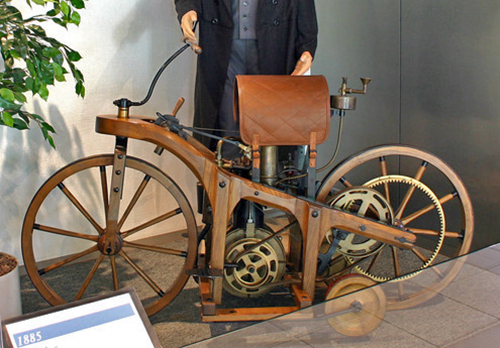 One of the first types of bicycles powered by something other than legs was the 1867-69 Michaux-Perreaux steam velocipede, with a small steam engine attached to the bike. It was created around the same time as the Roper steam velocipede in Boston, Massachusetts, which featured a coal-powered steam engine; Roper died in 1896 while riding his steam bike.
One of the first types of bicycles powered by something other than legs was the 1867-69 Michaux-Perreaux steam velocipede, with a small steam engine attached to the bike. It was created around the same time as the Roper steam velocipede in Boston, Massachusetts, which featured a coal-powered steam engine; Roper died in 1896 while riding his steam bike.
In 1881, Lucius Copeland developed a small steam boiler attached to a bicycle, which could reach a top speed of 12mph. Four years later, Gottlieb Daimler and Wilhelm Maybach created the petrol-powered Reitwagen; Daimler (of the eponymous car company) is often referred to as “the father of the motorcycle.”
The Reitwagen employed a four-stroke internal-combustion engine designed by Nicolaus Otto, of whom Daimler had been an employee, and was often referred to as the “bone crusher”, after similar wooden-framed bicycles that had no suspension and therefore offered an incredibly jarring ride. Daimler and Maybach were relentless inventors, and Daimler later became one half of Daimler-Benz, the company now known as Mercedes-Benz.
After Daimler and Maybach’s invention, many other industrious people, in Europe and the US, began to develop similar powered bicycles, and in 1894, the German company Hildebrand and Wolfmüller established a production line for what were now called “motorcycles”. Four years later, Charles Metz became the first US-based producer of motorcycles, manufacturing the Orient-Aster, which was unveiled to the public at a race track in 1900, completing the five-mile (eight-kilometre) course in seven minutes.
As mass production became a more efficient and cost-effective means of manufacturing at the turn of the 20th century, many more companies either sprang up anew or turned their focus towards motorcycles.
Royal Enfield, which had formerly produced bicycles and quadricycles in Redditch, Worcestershire, produced a 239cc motorcycle in 1901, and Triumph, a bicycle maker, offered its first motorcycle in 1902. After being saved from bankruptcy, Triumph has continued to produce motorcycles, making it the oldest manufacturer in ongoing production.
The US also became a major centre of production, with the Indian Motorcycle Manufacturing Company producing the “Indian Single” in Massachusetts in 1901, followed by Harley-Davidson in 1903 in Wisconsin. Both companies managed to survive the Great Depression, and despite changes of ownership and periods of instability, both still thrive to this day.
With the invention of more powerful and more reliable engines, motorcycle racing became increasingly popular, and many of the modifications instilled in these racing bikes soon found their way into the mass-produced motorcycles.
Off-Road Motorcycles
Not long after these early versions of true motorcycles began being produced (1901 - ), motorcyclists soon discovered that unsealed roads offered no barriers to the motorcycle. The more adventurous motorcyclists then began to venture down tracks and trails, with various degrees of success, and suddenly motorcycling was also off-road.
Off-Road racing first evolved in Britain from motorcycle trials competitions, such as the Auto-Cycle Clubs's first quarterly trial in 1909 and the Scottish Six Days Trial that began in 1912. It was shortly after this that the three most well known forms of off-road motorcycling forked.
Trials - became the sport that utilised the more technical and specialised aspects of the early Scottish Six Day Trial, emphasising staying upright and onboard through the most harrowing terrain.
Motocross - When some of the organisers of the Scottish Six Day Trial dispensed with delicate balancing and strict scoring of trials in favour of a race to become the fastest rider to the finish, the activity became known as "hare scrambles". 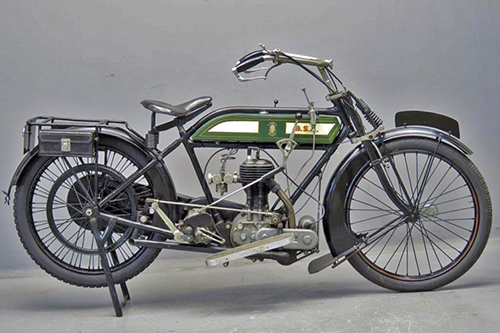 Though known as scrambles racing (or just scrambles) in the United Kingdom, the sport grew in popularity and the competitions became known internationally as "motocross racing", by combining the French word for motorcycle, motocyclette, or moto for short, into a portmanteau with "cross country". The first known scramble race took place in Camberley, Surrey in 1924.
Though known as scrambles racing (or just scrambles) in the United Kingdom, the sport grew in popularity and the competitions became known internationally as "motocross racing", by combining the French word for motorcycle, motocyclette, or moto for short, into a portmanteau with "cross country". The first known scramble race took place in Camberley, Surrey in 1924.
Enduro - motorcycles specifically intended for enduro competition first appeared at the International Six Day Trial (ISDT) now called the International Six Days Enduro (ISDE). The ISDE was first held in 1913 at Carlisle, England. The ISDE requires an enduro motorcycle to withstand over six days and upwards of 1250 km (777 miles) of competition; repairs are limited to those performed by the rider with limited parts. The ISDE has occurred annually, apart from interruptions due to World War I and World War II, at various locations throughout the world. The early events were a test of rider skill and motorcycle reliability. The earliest ISDE courses used the dirt roads common in that era. Today, most of the routes are off-road. In 1980, the ISDT was renamed the International Six Day Enduro (ISDE).
Although the bikes involved in these early events were "Off-Road", they were still in essence, just road bikes with minimal modifications.
It is a widely held, and often repeated, belief that the first true off-road (Dirt) bike was the 1914 BSA Scrambler (a motorcycle that never existed), introduced by Siegfried Bettmann. This is untrue for various reasons, not the least of which is that Siegfried Bettmann was the founder of the Triumph group of companies in 1886 (first motorcycle manufactured in 1902), and had nothing to do with the British Small Arms (BSA) company, founded in 1861 (first motorcycle manufactured in 1910). A look at 1914 models from either brand should demonstrate that design at that stage was far from anything that could be truly called off-road.
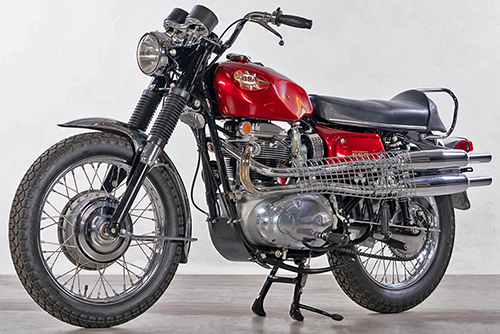
Perhaps this erroneous belief was propagated by the actual BSA "Scrambler" models, produced by BSA (who had bought out Triumph in 1951) between 1957 and 1971.
The first was the A10S 650 Spitfire Scrambler (1957-63), followed by the C15 250 Starfire Scrambler (1960), the B25 250 Starfire Street Scrambler (1969-71), and the A65F 650 Firebird Scrambler (1968-71). Unfortunately most of these models narrowly preceded the demise of BSA-Triumph in 1972.
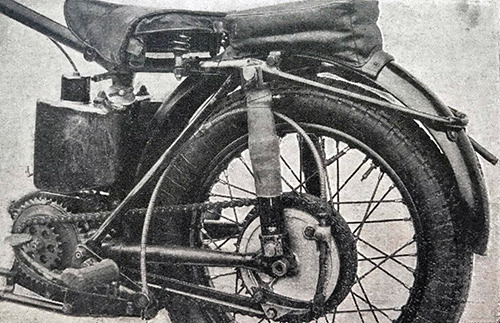
From the advent of off-road motorcycle competitions, motorcycle designers realised they needed to produce machines that were lighter, stronger, had longer travel suspension, and protection for engine parts. Slowly these aspects of design were addressed. Firstly, there was the "upswept" exhaust systems, then in 1908 undamped telescopic forks were used on bikes made by The Scott Motorcycle Company. The first production motorcycles with hydraulically damped telescopic forks were the German BMW R12 and R17 in 1935. In 1936, the biggest breakthrough for off-road bikes came when Velocette tested hydraulically-damped rear shock absorbers on a pivoting rear swingarm.
From this point on, it would be fair to say that motorcycle developers had all the technical design information they needed to create the first true off-road bikes. The next giant leap in off-road design came in the mid '50's when lighter, more powerful 2-stroke engines were introduced.
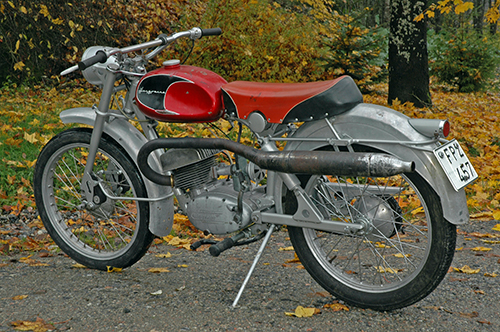
In 1955, the Swedish company Husqvarna introduced the 175cc Silverpilen (meaning “silver arrow” in Swedish), which was designed for cross-country racing. The Silverpilen was a lightweight motorcycle with a two-stroke engine, high ground clearance, and knobby tires for better traction on dirt and gravel.
Over the next few years, Husqvarna continued to refine their dirt bike design, adding features like better suspension and larger engines. In 1960, they introduced an updated version of the Silverpilen, which became known as the “Husky.” The Husky had a 175cc two-stroke engine, a lightweight frame, and rugged tires, making it ideal for off-road racing.
In 1965, Husqvarna introduced the Husqvarna 250cc, which became the first true production dirt bike. The Husqvarna 250cc had a larger engine and more advanced suspension, making it even better suited for off-road riding and racing. It quickly gained popularity among riders and helped establish Husqvarna as a leading manufacturer of dirt bikes. By this time however, many other European motorcycle brands (such as the Spanish Montessa, Bultaco and Ossa; the German Maico and KTM; and the traditional 4-stroke powered British Ariel, Triumph, BSA, AJS/Matchless, Norton, etc.) had been actively involved in off-road manufacturing for almost a decade also.
Thus, the era of the modern Dirt Bike had finally arrived.
Kawasaki
Kawasaki motorcycles may be known today as mean green riding machines, but it initially didn't start off without some mild controversy. 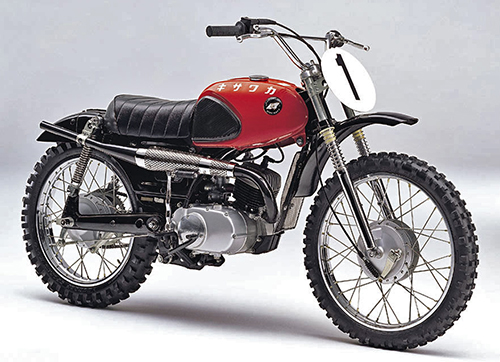 At the 1969 Daytona 200, the company left onlookers stunned by having its team of riders consisting of Dick Hammer, Art Bauman, Ken Araoka, Cal Rayborn, and Walt Fulton III and their fleet of 250cc A1RA and 350cc A7RA racers appear in a striking green and white color. Both racers and manufacturers such as Harley-Davidson alike have long remained superstitious when it came to the color, with many identifying green as unsafe.
At the 1969 Daytona 200, the company left onlookers stunned by having its team of riders consisting of Dick Hammer, Art Bauman, Ken Araoka, Cal Rayborn, and Walt Fulton III and their fleet of 250cc A1RA and 350cc A7RA racers appear in a striking green and white color. Both racers and manufacturers such as Harley-Davidson alike have long remained superstitious when it came to the color, with many identifying green as unsafe.
Created by designer Chris Kurishima and painter Rollin "Molly" Sanders, Kawasaki's motivation for the daring color choice was to help their riders stand out from the competition, especially given that the event would also be debuting on television in full color. While Kawasaki didn't win the 1969 event, the green coloring nevertheless succeeded at leaving an indelible impact that would go on to affect the company's branding soon after.
Many of their future motorcycles and race bikes went on to adopt the green color. The moniker "Green Meanies" began to become associated with Kawasaki motorcycles as the company saw continued victory at various racing events and championships. Over time, lime green evolved from a simple gimmick into a powerful statement of Kawasaki's never-ending quest to innovate and think outside the box, leaving all its competitors in the dust.
Kawasaki's first motocross machine was the B8M (at this time the motorcycle arm was still called Meguro), which was based on the B8, a 125cc practical-use bike. Before it was released in 1963, Kawasaki’s in-house team entered the MFJ race held in Aonogahara, Japan, where they swept the top six places on a modified B8. At the time, Kawasaki Aircraft Industries was at a crossroads, trying to decide whether or not to continue with their struggling motorcycle business, but the B8's success gave the brand a boost in popularity and encouraged its continued challenge. The production B8M’s red fuel tank became a symbol of Kawasaki until the debut of the KX.
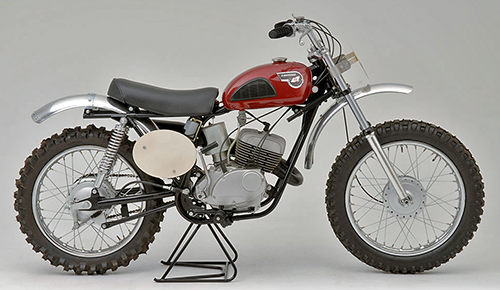
In 1967, Kawasaki introduced the F21M, this was Kawasaki’s first 250cc production motocross machine. It featured a 21-inch front tyre at a time when 18-inch front and rear tyres were the norm. The bike had a good balance between engine performance and chassis rigidity, and featured rotary disc valves, a double-cradle frame with an underloop and Ceriani forks. In the recently-established All Japan Motocross Championship, Kawasaki factory rider Takashi Yamamoto won the 250cc title two seasons in a row in 1967 and 1968.
1971 saw the KX250 and KX125, which were the first production motocross machines to officially feature the Lime Green colour. The 125 was equipped with rotary disc valves while the 250 featured piston valves. With the kind of volume for the expansion chamber only possible with a down-chamber design, the engine’s high output and strong torque were well received.

When sales first started in 1973, they were named the 250MX and 125MX, but their model names, KX250 and KX125, were the same as the factory race machines. From 1975 onward, the names were changed to KX250 and KX125, marking the start of the KX series.
In 1979, Kawasaki introduced the Uni Trak suspension on factory racebikes around the world. The early model pushrods were round steel pipes rising from the bridge that joined the left and right sides of the swingarm and meeting at the bellcrank at the top to form an inverted “V” shape. The rear fender featured integrated side number plates, which went on to be used on late model production KXs.

The 1979 KLX250 was an enduro machine with a KL250 (dual-purpose) air-cooled OHC 2-valve engine mounted in a KX125 chassis. Customers loved it for its mild, easy-to-use power characteristics, which were thanks to larger-diameter carburettor and intake and exhaust valves, in addition to a newly designed exhaust system. Compared to the more racing-oriented two-strokes of the time, models with four-stroke engines were seen more as play bikes. This bike featured an I-beam aluminium swingarm and had an impressive 250 mm front and rear wheel travel. It could be argued this was the genesis of the KLX650.
Following the KLX250, a string of two-stroke machines debuted beginning with the 1979 KDX400, and as two-strokes became a new category, it was the 1980 KDX175 that went on to become a bestseller. It later evolved into the KDX200 and formed the core of a Kawasaki line-up that also included the KDX80, KDX250 and KDX450. Initially air-cooled engines were standard because in desert conditions the availability of water was not guaranteed, but eventually liquid-cooled engines were adopted for the high-performance KDX series.
The 1982 KX125 was released during a tumultuous period when it was normal for models to receive full model changes every year. It was loaded with new technology including the first front disc brake on a production motocrosser, a liquid-cooled engine, the latest evolution of Uni Trak rear suspension, a gold-anodised aluminium swingarm, and a rear fender with integrated number plate, among others. For that reason, it is still considered one of the most iconic Kawasaki models in the brand’s long history. The KX125’s large overall size—with a 300 mm front and rear wheel travel—set the standard for many machines to follow in the 1980s.
Kawasaki had fielded the KX400, KX420 and KX450 in open-class racing, but when the maximum allowed displacement was raised to 500cc in 1983, it led to the creation of the KX500. AMA National 500 champions on Kawasaki's monster machines included Brad Lackey, Jimmy Weinert, Jeff Ward, Mike Kidlawski and Mike LaRocco. Cancelled in 1993, the 500 class only lasted 10 years, but in the final years of its existence Lime Green went on a rampage.
AMA National Motocross triple-crown (125/250/500) winner Jeff Ward clinched his first title on the KX125SR in 1984. That season, Kawasaki sent the first engine with KIPS to the USA mid-season during a close battle for the lead, which eventually helped Ward win the title. The machine had many elements that showed Kawasaki’s ingenuity, including an asymmetrical design that featured a single vertical radiator on the left side, a cool air intake with a duct that went through the aluminium fuel tank, and others.
The KX250SR that Atsushi Okabe rode on his way to winning the 1989 All Japan Motocross 250cc title, had many design innovations. Instead of the single backbone design that had been used until that time, it featured a new perimeter frame made up of two square pipes. This model and its new technology caused a sensation in the motocross world as a clear embodiment of how Kawasaki had continuously led with groundbreaking technology. The perimeter frame was featured on the production KX250 and KX125 from the following model year, 1990, and went on to become the foundation for the aluminium frames of today.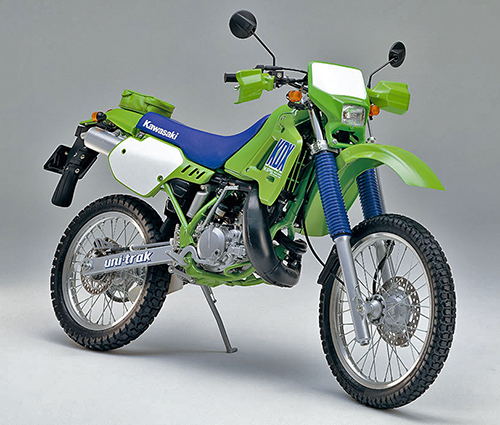
In 1989 the air-cooled-engined KDX200 enduro model underwent a full model change to be reborn as the water-cooled KDX200R (racing specification) and KDX200SR (street specification). The landmark change that these two models represented marked the start of Kawasaki developing enduro and dual-purpose models alongside each other. The KDX220R/KDX220SR and KDX250R/KDX250SR were later built on the same concept and became quite popular as customers responded well to Kawasaki’s focus on racing.
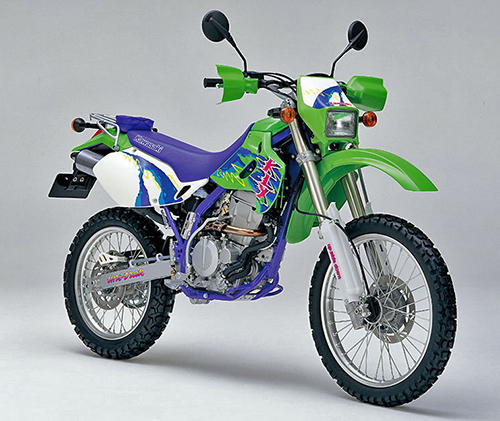
Following the success of the KDX series, 1993 saw the 4-stroke KLX250R (racing specification) and KLX250SR (street specification) models released. Kawasaki's off-road vehicle lineup was now complete with both two- and four-strokes featured. The high-spec KLX was a huge hit as a razor-sharp off-road racer, boasting a KX-like perimeter frame, slim and lightweight chassis, and a high-performance liquid-cooled DOHC 4-valve engine. The KLX250ES, equipped with an electric starter, was later added to the lineup.
KLX650
The same year that the KLX250 series was introduced, saw the introduction of the larger, more powerful KLX650, showing the world that Kawasaki were indeed serious about 4-stroke Enduro/Dual-Purpose motorcycles.
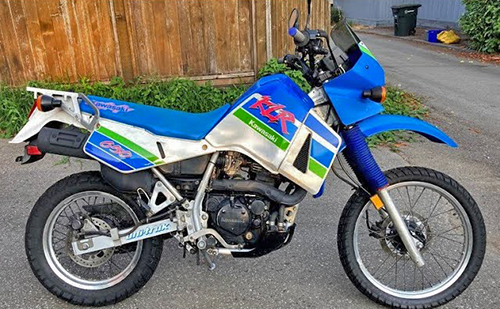 The 1993 KLX650 series was the end result of internal pressure within Kawasaki to produce something more competitive against the likes of the off-road conquering Yamaha TT600, Honda XR600 and KTM LC4.
The 1993 KLX650 series was the end result of internal pressure within Kawasaki to produce something more competitive against the likes of the off-road conquering Yamaha TT600, Honda XR600 and KTM LC4.
Like Suzuki with their DR Series, Kawasaki had languished with their 4-Stroke off-road models, content to let the aging KLR650 lift all the weight. Serious off-road users weren't buying it, knowing full well the limitations of this weighty, under-powered and inadequately suspended bike.
(The Kawasaki KLR650 is a 652 cc (39.8 cu in) dual-sport motorcycle intended for both on-road and off-road riding. It was a long-standing model in Kawasaki's lineup, having been introduced in 1987 to replace the 564 cc (34.4 cu in) 1984-1986 Kawasaki KLR600, and remaining almost unchanged through to the 2007 model. The 2008 model was the first significant redesign of the KLR650 since its inception. It was built with a 652 cc four-stroke, DOHC, dual-counterbalanced, single-cylinder, water-cooled engine. The second significant redesign in 2022 added new features such as electronic fuel injection and an anti-lock braking system.
The KLR is widely used as an inexpensive adventure/touring bike. The addition of luggage and personalized modifications [GPS, heated handgrips, larger windscreens] make it more functional on long trips. The bikes have been used for long distance and intercontinental trips, as well as full global circumnavigation rides e.g., by Dr. Gregory Frazier in 2001 and 2002.)
The Honda XR600, Yamaha TT600, Husqvarna TE610 and KTM LC4 had proven that modern 4-Stroke technology was still very much competitive in the off-road scene, which had been dominated for so long by 2-strokes.
Although inherently more agile and more powerful, the 2-stroke off-roaders lacked the low-end torque, engine braking and smoothness of the 4-strokes. Honda, Yamaha, Husqvarna and KTM demonstrated that by reducing overall weight and increasing engine output, the slow old "thumper" could once again hold its own. This was hardly a flash in the pan either, as the 4-stroke domination in off-road motorcycles continues to this day with the likes of the Kawasaki KX450, Honda CRF450R, Suzuki RM-Z450, Yamaha YZ450F and the KTM 450SX-F motocrossers.

The KLX650 was an instant hit, competing more than favourably against the TT600, XR600, Husqvarna TE610 and KTM LC4 600. In 1993, the KLX650R won a shoot-out against all of those models, showing its superior suspension and power spread. It endured from 1993 until 2003. A history of the various models is as follows -
1993 - KLX650-C1 (Electric start); KLX650-A1 (KLX650R - Off-Road only with kick start)
1994 - KLX650-C2; KLX650-A2
1995 - KLX650-C3; KLX650-A3
1996 - KLX650-C4 (USA only); KLX650-B1 (KLX650R with full registration compliance - Australian model); KLX650-D1 (KLX650R - Fully complianced for USA and Europe)
1997 - KLX650-B1; KLX650-D2
1998 - KLX650-B1; KLX650-D3
1999 - KLX650-B2; KLX650-D4
2000 - KLX650-B2; KLX650-D5
2001 - KLX650-B3; KLX650-D6
2002 - KLX650-B3; KLX650-D6
2003 - KLX650-B3; KLX650-D6